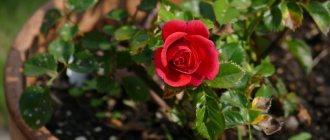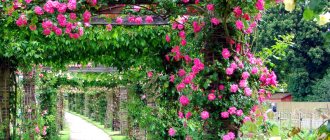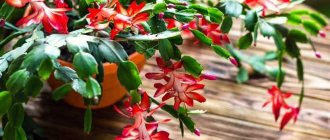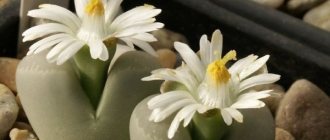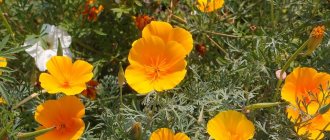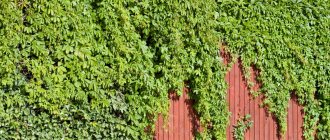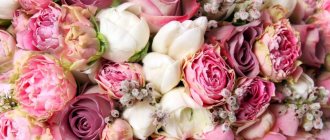Mysterious openwork fronds growing in the depths of the forest have always become characters in various legends, mystical stories and fairy tales.
A long time ago, a fern settled in the garden. Planting and caring for it require certain conditions of placement and moisture, otherwise the forest dweller is not picky.
Many nationalities still believe that once a year on the night of Ivan Kupala, an amazing flower blooms, bringing happiness to those who see it, or pointing out where the treasure is buried.
Alas, the lover of thick thickets does not bloom.
Due to their ability to reproduce by spores, the famous botanist Carl Linnaeus nicknamed ferns secretagogous plants.
Where are ferns found in nature?
They live in shady forests at the foot of tree trunks.
Some grow like epiphytes on the branches of large giants, adapt to cling to rock ledges, prefer wet banks of rivers and lakes, swamp hummocks, and even manage to perch on the walls of city buildings.
Ferns live everywhere, but their greatest diversity is in the humid tropics and subtropics.
However, there are many species that grow in temperate climates. Many of them are used in cultural cultivation. Among gardeners they are known under the common name - garden fern.
Botanical portrait
The oldest plants on the planet, ferns are extremely diverse and differ in their shapes, sizes, structural features and life cycle.
They don't have true leaves. What everyone calls leaves is more correctly called flat branches, or fronds, which are a whole system of pagons located in the same plane.
There are no flowers; they reproduce by spores or vegetatively - using fragments of rhizomes, fronds, buds, aphlebia (leaf-like processes at the base of the frond) and other methods, in particular by sexual reproduction in some varieties.
The spores, which are mistaken for fern seeds, are usually located on the underside of the frond.
Types of ferns grown in the garden
In temperate latitudes, plants with short stems buried in the soil are common. Fronds forming from the buds of the rhizome unfold above the ground surface.
They are characterized by apical growth, and their main purpose is sporulation and photosynthesis.
The following garden species most readily take root in shady areas of the middle zone:
Ostrich fern (Matteucia struthiopteris)
A graceful plant with aerial fronds one and a half meters high and approximately 1 m in circumference of the bush. It easily adapts to any conditions, is not picky about the composition of the soil, and is resistant to cold.
Its only whim is high soil moisture.
It prefers shade, in an open place it will grow shorter, and the fronds will be much lighter than those of the ostrich bird grown under the canopy of trees.
In August, sporophylls form in the center of the rosette - brown, feathery and leathery.
Adiantum pedatum
An extremely frost-resistant species, it is not afraid of temperatures of 35 degrees below zero. It loves moisture, but does not tolerate stagnant water.
The bush is round, with pinnately dissected fronds of light emerald color, cut along the edges, and bend in an arc.
Female stumpweed (Athyrium filix-femina)
An unpretentious species that will tolerate even stagnant water.
Many varieties have been bred that are distinguished by their decorative properties; flower growers especially love LadyinRed - with red petioles and openwork dissected fronds.
However, at the end of summer or beginning of autumn, after sporulation, they turn brown and look undecorative.
Japanese stumpweed (Athyrium niponicum)
Well suited for growing in the middle zone, it loves moist, nutritious forest soil and shade, and copes with low winter temperatures.
Beautiful varieties of Metallica and Ursula's Red are known, which have fronds with a silver tint and purple veins.
Royal Osmunda (Osmunda regalis)
One of the most spectacular ferns with large, often almost two-meter leaves.
It is quite frost-resistant, but gardeners with experience in growing it still advise mulching the soil around it.
Osmunda requires regular watering; its spores, like ostrich, quickly lose their viability; they must be sown only when freshly collected.
Bracken Fern (Pteridium aguillinum)
It is distinguished by graceful double- and triple-pinnate fronds on long petioles, rigid, triangular-ovate in shape.
Bracken is characterized by rapid growth, which turns into a disorderly cover.
The peculiarity of the plant is that its spore sacs are hidden in the folded edges of the leaves, and not like other ferns - simply attached to the underside. Used for food and in folk medicine.
Phyllitis sclopendrium
The popular synonym is “deer tongue.” It has fronds without dissection, which makes it different from other ferns.
It grows up to 50 cm, is thermophilic, requires shelter for the winter.
Multirow fern (Polystichum) - several species from a large genus are grown in the garden - Brown's (Polystichum braunii), top-fern (Polystichumacrostichoides), spiny (Polistichumaculeatum) and other herbaceous plants with leathery dense fronds growing from an obliquely growing rhizome. They are characterized by slow growth.
Ground cover ferns include several low and very showy plants:
Linnaean's fern (Dryopteris Linnaeana) – the root system of the fern is highly branched and rapidly growing. The fronds are openwork, light green in color, triangular in outline, with twice pinnately dissected lobes. The spores ripen in June.
Woodsia ilvensis
The plant is only 10-20 cm tall, can withstand both frost and drought, but suffers greatly from direct sunlight, so it is planted only on the north side of buildings.
Hair-like bone (Asplenium trichomanes) is the same low species as the previous one, growing no more than 20 cm in height. Prefers to grow in alkaline soil.
Centipede fern (Polypodium vulgare)
It forms a dense, beautiful canvas, which is often used for landscaping the roofs of high-rise buildings.
Salvinia natans
The most common fern for ponds is considered to be floating salvinia - an annual plant with pale green fronds, collected in pairs in whorls and drifting on the surface of the water. With the arrival of autumn, it sinks to the bottom, only spores overwinter.
Popular varieties
To achieve success when cultivating ferns in the garden, you need to choose the right type of plant.
Female Kochedyzhnik
This crop is characterized by dissected leaves that form bunches. Under natural conditions, it grows in swamps, forming hummocks. The size is determined by the crop variety and can reach 30-70 centimeters. The roots of the bush are short and thick.
Common bracken
This plant reaches 70 centimeters in height. It grows well in dry soil, which contains a small amount of useful substances. The culture is characterized by long horizontal leaves resembling eagle wings. The plant contains toxic substances, which is why it poses a danger to pets. Moreover, this type of fern is absolutely harmless for people.
Male shieldweed
Under natural conditions, the culture develops in the shade and reaches 0.3-1.5 meters. Pores resembling a shield accumulate on the underside of the leaves.
Common ostrich
This crop is distinguished by feathery leaves that resemble the openwork pattern of ostrich feathers. They can reach 1.5 meters in size. With the arrival of spring, the leaves become like a rolled cocoon. Then they bloom and resemble a luxurious cone. The vertical root system requires systematic loosening and mulching.
Asplenium
The culture is popularly called Kostenets. Most aspleniums need warmth. However, there are also frost-resistant crops that can withstand temperatures down to -18 degrees.
See also
Growing and caring for Schisandra chinensis, planting secrets
Nest-like asplenium
This plant is able to grow even without soil, since under natural conditions it takes root on leaves and trunks. The size of the culture reaches 1 meter. Its dwarf species are found in flower shops.
Bulbous asplenium
This is a deciduous fern native to New Zealand. It can be grown in the garden. In this case, it is recommended to cover the root system with dry leaves. You can also dig up the bush and keep it in the cellar until spring arrives. The length of the plant reaches 60 centimeters.
Conditions for growing ferns in the garden
The most suitable place for perennials in the garden is a corner protected from direct rays on the north side of buildings located on an area where shade remains most of the day.
Most of them do not like the sun, but if you provide good watering, then in an open, illuminated place you can plant female kochedednik, osmunda, and onoclea.
Polygonum, shieldweed and telipteris do not tolerate bright light at all.
Ferns prefer light and nutritious garden soil that is constantly moist. They feel good near bodies of water.
Slightly acidic soil is suitable for ostrich, nocturnal, Linnaeus, and onoclea; male shield and telipteris marsh grow on swampy acidic soil.
Fertilizer
Feeding the fern is not necessary, since it feels fine without it. If they become pale and small, this indicates a lack of nutrients in the soil.
The plant needs feeding during the period of active growth - late spring and summer. It is advisable to fertilize using liquid complex mineral compositions, for example a solution, 1 liter of which includes:
- potassium salt – 1 g;
- superphosphate – 1.5 g;
- ammonium nitrate – 1.5 g.
You need to use organic matter with caution, as it can cause burns. Some gardeners periodically add tea leaves to the pot or water with a weakly infused drink.
Features of fern propagation
Of all the possible methods in garden floriculture, propagation by spores and division of overgrown bushes is usually used.
Growing fern from spores
The spores ripen in August - from yellowish-green to brown.
They look very small and delicate, and are incredibly afraid of drying out and sunlight.
They are sown in containers filled with peat, and the crops are covered with glass on top or the entire container is placed in a transparent plastic bag.
The substrate inside is constantly kept moist.
Shoots appear after 2 weeks or a month.
Young seedlings are planted twice, grown for at least 2 years and only then transplanted into open ground.
Plants grown in this way are distinguished by powerful bushes and resistance to adverse environmental conditions.
Dividing the bush
Most garden ferns are propagated by fragments of rhizomes or by dividing the bush into several parts.
Use sections of rhizome 20-25 cm long; they should have at least 2 buds.
Those species that have a short rhizome and a rosette growth form are divided if small daughter rosettes have formed next to the adult specimen.
It is best to divide the bush in early spring in cool, cloudy weather, before the fronds have yet developed.
They dig up the bush, cut it between the rosettes with a sharp knife so that well-developed roots in sufficient quantities remain on each section.
The sections are sprinkled with cinnamon or crushed charcoal. After transplanting, the plants are well watered.
It is permissible to divide the bush in the fall at the beginning of September or even at the end of summer - in the last days of August.
The main thing is that the weather on the day of transplantation and for several days after is cool.
Those ferns that grow with only one growth point and do not form rosettes reproduce exclusively with the help of spores.
Features of planting ferns in the garden
Having chosen a suitable place, plant the plant in a shallow hole commensurate with the root system of the plant.
The holes are placed at a distance of 30-50 cm from one another, guided by the expected size of an adult perennial.
A mixture of peat, compost and sand, taken in equal quantities, is poured into the bottom of the hole.
The perennial is positioned so that the base of the frond is not too buried in the ground, watered thoroughly and sprinkled with soil dug out from the hole.
Planting a fern is completed by mulching the soil around the plant to retain moisture with last year's dry leaves or pine needles.
Emerging issues related to landing
The question often comes from flower growers is whether it is possible to plant ferns near the house.
Having rejected all mystical warnings, experts boldly answer them - as many as they like, only from the north side and in the shade.
Similar doubts arise in connection with statements about the energy vampirism of the plant.
They arose due to the ability of the fern to absorb a lot of oxygen at night, so in a living room where people sleep, you cannot place a pot with an indoor fern - the next morning you will get a migraine.
However, this does not apply to garden ferns, because they grow in open spaces, and the amount of oxygen they absorb will not affect those around them.
Another question arises - how often can a fern be transplanted? The less often the better.
Plants do not like to have their root system disturbed, especially by division.
Powerful, beautiful bushes take several years to form; any intervention in this process stops their development.
Beneficial features
Many indoor plants are known for their special energy in our home.
Fern is no exception. There are beliefs that fern softens hot-tempered people and extinguishes their attacks of aggression. It also helps to harmonize family relationships and brings good luck to the home.
At the same time, some people consider the fern to be an energy vampire, taking power from the atmosphere for its development.
If you are afraid of this property, place the plant near the TV or in a place where negative energy accumulates.
But it has undeniable beneficial properties:
- Can be used for food. Its calorie content is only 34 kcal, while it contains a large amount of protein and nutrients. In this regard, its benefits are invaluable for people maintaining a low-calorie diet.
- Helps fight parasites. The roots have an anthelmintic effect.
- Absorbs electromagnetic radiation from household appliances.
- Treats eczema, wounds, abscesses.
- Helps in the treatment of rheumatism. In this case, it is recommended to take baths with the addition of a decoction of the plant.
It is prohibited to use fern-based preparations during pregnancy.
Best tips for caring for ferns outdoors
The main care measures involve regular watering of plants, especially in hot summer weather.
The amount of water is not particularly limited if the surrounding air is dry - the plants are also sprayed using spray nozzles for a hose or watering can.
The soil for ferns should be constantly moist.
After drying, it is carefully loosened so as not to catch the root system of the plant, and weeds are removed.
At the beginning of the growing season, perennials are fed once every three weeks with complex mineral fertilizers, and organic matter is added in early spring.
Preparing the fern for winter involves mulching the root space with peat, as well as covering it with spruce branches or fallen leaves.
For frost-resistant species, it is enough to sprinkle the center of the bush with dry leaves, although many plants can do without this.
Diseases and pests of ferns
The decorative appearance of fern plantings is seriously spoiled by slugs and snails that live in humid environments.
They are collected manually; if the colony is numerous, metaldehyde preparations are scattered between the bushes.
A serious problem for plants is bacterial and fungal infections, which cause rotting of the rhizomes and, as a result, the death of the entire bush.
The appearance of brown spots on the fronds is a signal for immediate action.
The affected fronds are cut off and burned, and the entire plant is treated with a fungicide, for example, Maxim.
To prevent diseases, they try to water so that the stream of water does not fall into the center of the bush.
Diseases and pests
Ferns rarely encounter diseases. They usually develop when plant care rules are violated or weeds actively grow in the area.
Fungal infection
When a fern is infected with fungi, the leaves become yellow. Over time, they turn brown and die. There is also a risk of dark plaque appearing on the back of the leaves or damage to the central veins. In such a situation, the plant will have to be removed, and the infected soil will have to be dug up and thrown away.
See also
How to care for monstera at home, planting and propagation
In simple cases, treating the crop with chemicals – fungicides – is sufficient. In this case, it is recommended to tear off dry and diseased leaves and burn them. Subsequently, the crop must be properly watered and loosened.
Bacterial infection
As a bacterial infection develops, the fern leaves become covered with brown or rusty spots. There is also a risk of the formation of pinpoint or concentric marks or watery formations. If such problems occur, the affected areas should be immediately cut off and burned.
Adjusting the watering regime is of no small importance.
Shchitovka
When these insects attack, brown shields appear on the leaves. Parasites accumulate under them. You may also notice leaves falling. To cope with the problem, pests should be removed with a brush. After which it is recommended to treat the culture with a soap solution. Infusions of garlic or walnut leaves are considered effective.
Mealybug
When a bush is infected by these pests, the leaves become covered with a cotton-like coating. Female scale insects accumulate under it. Parasites are localized on petioles, flowers, leaves, and trunk. They can often be found in the axils of leaves.
To cope with the problem, it is recommended to cut and burn the damaged areas, and remove the top layer of soil.
Aphid
When a plant is infested with aphids, the fern leaves become sticky and deformed. Parasites are usually localized on the underside of leaves and accumulate in the axils. They can be of different colors - green, pink, black. When a crop is infected, insects absorb all the juices of the plant. As a result, it loses its decorative properties. In this case, the leaves become deformed and die. In addition, aphids lead to the spread of viral infections.
To cope with parasites, the plant should be wiped with soapy water and treated with a 3% Chlorophos solution. From folk remedies, you can use an infusion of tobacco or ash. In case of severe damage, the plant should be cut off at the root. In most cases, the fern sprouts new shoots and eventually recovers completely.
Ferns in garden design with other plants (photo)
Spectacular forest aliens add the natural mystery of a virgin corner of nature to the atmosphere of any garden.
The plant looks great on the shore of a reservoir, along garden paths, in the tree trunks, ideal for creating rutariums or rockeries, for decorating the northern shaded slopes of alpine hills.
1 of 3
Excellent partners for ferns in creating beautiful garden compositions are various varieties of hosta, bergenia, lungwort, heuchera, astilbe, as well as conifers - junipers, thujas, fir, cypress.
Mystical ferns are able to give the garden the character of a forest natural corner and enchant every traveler with the openwork curve of the airy emerald foliage.
Temperature
How to care for a fern at home so that the plant does not die? It is necessary to ensure the optimal temperature. It is 15-22 degrees. But the specific regime is selected based on the type of plant.
Eat:
- Heat-loving. These include nephrolepis, asplenium, platycerium. In winter the temperature should be at least 18 degrees.
- Resistant to low temperatures. This is a polypodium, pimpulate, pellea. Plants can live at temperatures as low as 12 degrees.
Any type of fern does not need drafts, but they thrive in fresh air. The room where the flower is located should be regularly ventilated.

